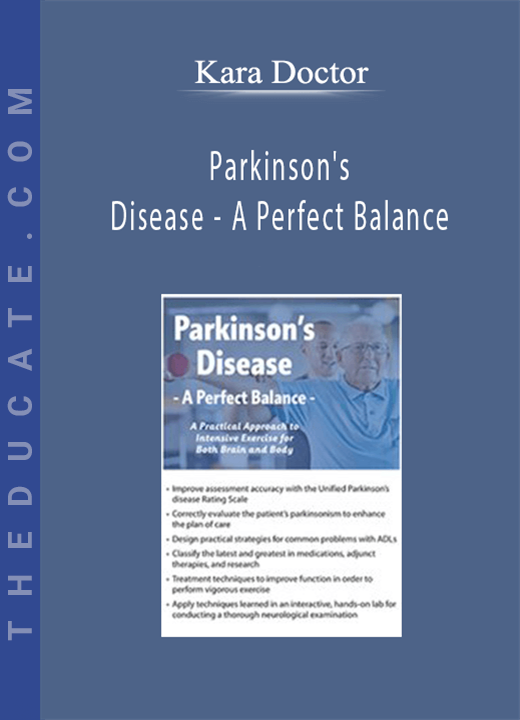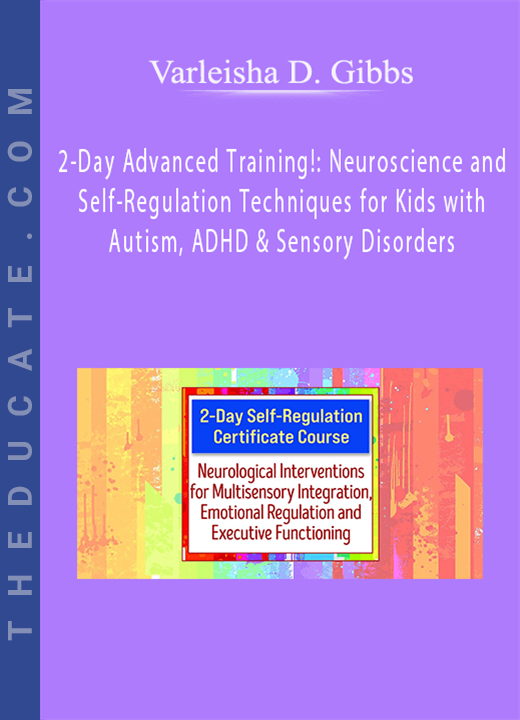Description
Parkinson’s Disease – A Perfect Balance – Kara Doctor
From the initial symptom to diagnosis, Parkinson’s disease affects many aspects of an individual’s life, including sense of smell, facial expression, voice volume, ability to swallow, stiffness of the muscles, gait, balance, digestion, salivation, and fine motor control. With the alarming rate of PD being diagnosed to patients younger and younger, clinicians need the right tools at their disposal to combat this degenerative disease.
It is our job as clinicians to educate those diagnosed with Parkinson’s how to begin exercising in a way that will benefit their brain, their cognition and potentially slow the progression of the disease. Understanding the symptomatology of Parkinson’s is important in developing an effective exercise program for each individual. Progressive, vigorous exercise has been shown to slow the decline in quality of life in people with Parkinson’s. Through this lab-intensive recording, you will discover effective strategies to teach your patients that they can use in their day-to-day struggle with Parkinson’s.
- Identify neuroanatomy structures affected by Parkinson’s disease and be able to explain common responses and changes to the structures with vigorous exercise
- Articulate primary, secondary, and tertiary symptoms and complaints of Parkinson’s and parkinsonism
- Determine when DBS should be introduced and articulate potential candidacy and efficacy of surgical treatment
- Identify scales and scores that quantify symptoms of Parkinson’s to show a baseline, as well as improvement with treatment
- Review medication for Parkinson’s, as well as common adverse effects and pitfalls
- Develop exercise programs for progressive, resistance training and increase intensity exercise for persons with Parkinson’s disease
PARKINSONS DISEASE OVERVIEW AND REVIEW OF ANATOMY
- Prevalence
- Incidence
- Economic impact
- Anatomy
- The subthalmaic nucleus
COMMON SYMPTOMS
- Types of parkinsonism
- Common motor symptoms
- Sensory disorders
- Loss of function
- Depression and apathy
- Swallow dysfunction
- Hypophonia
EXERCISE BENEFITS
- Types of exercise
- Neuro plasticity
- Early intervention
- Activity dependent improvement
- Baseline measurements
- Heart rate/perceived exertion
DEEP BRAIN STIMULATION
- Overview
- Candidacy Requirements
- Clinicians role in education
- Patients expectations and limitations
- Indications/Contraindications
BASELINE AND OUTCOME MEASUREMENTS LAB
- UPDRS Testing: The Gold Standard
- Tinetti balance and gait assessment
- Hoehn and Yahr Staging System
- Schwab and England ADL score
- Montreal Cognitive Assessment Test
- Neurological Examination
MEDICATIONS
- Levodopa drugs
- Levodopa Agonists
- Supplements
- Adverse effects vs. benefits
- Impact on exercise and functional mobility
THERAPEUTIC EXERCISE TECHNIQUES AND LAB
- Exercise techniques- rigorous exercise
- Strength training/Big body movements
- Facial and lingual exercises
- Voice exercise techniques
- Compensatory techniques to improve swallow
- Oculomotor exercises







12 reviews for Parkinson’s Disease – A Perfect Balance: A Practical Approach to Intensive Exercise for Both Brain and Body – Kara Doctor
There are no reviews yet.